Cali Cultura Report
The Latino Arts Network of California (LAN) was born out of a chain of cultural centers that linked the state. LAN is dedicated to strengthening and deepening the cooperative relationship among California’s Latino artists, arts organizations and the communities we serve.
LAN California Cultura Report
The purpose of this report and reason for our interest in engaging in this study, was to further review what we had already investigated from our own Cultural Vitality Index Project; the seemingly disparate distribution of funds and lack of resources in the Latino art and cultural field in the state of California. Three significant factors were at the heart of our effort:
- The dramatically shifting demographics and growing Latino population in California.
- The rising climate of acrimony and hate being directed at Latino people in the United States.
- The belief that arts and culture is vital to the Latino community, and that equity and access are key to a successful climate of growth and representation.
Our goal was to use available database information to track trends and identify opportunities and challenges. In the course of our study we encountered a number of unexpected challenges in utilizing the data to quantify the presence of Latino arts organizations in California, notable consistency and accuracy in the collated data and the overall lack of participation by Latino arts groups. We veered toward evaluating the California Cultural Data Project process itself to help understand, identify and provide a more qualitative profile of the Latino arts community.
The purpose of this report is to begin to quantify funding to California-based Latino arts organizations and assess how equitably funding and resources are allocated among the sector and throughout the state. We explored how well the California Cultural Data Project (CDP) is able to serve the Latino Arts Community in order to improve its overall impact and use.
Results from this report reveal the following:
- Latino’s make up 40% of the population yet less than 5% of the organizations that make up the state’s CDP roster, and in 2011, represented only 2% of foundation, corporate and public arts funding in California according to the CDP.
- Of the approximately 1,700 profiles reviewed, only 79 reflect a credible presence as being a Latino arts organization or significantly serving a Latino audience.
- Latino organizations average $113,000 in budget size; in essence, the majority are small-sized organizations no matter that a dozen have over 40 years in operation.
- Latino arts organizations produce and present events and programming in commensurate proportion to larger and mainstream organizations with far fewer resources.
- Latino organizations rely heavily on volunteers and in-kind services in proportion to mainstream organizations.
- Latino organizations are multidisciplinary and multi-purpose in practice, serving as community service organizations, destinations and hubs of activity in addition to serving as cultural art centers.
- Most of the cultural centers in Latino communities do not own their space. They rent, or lease, or in some cases occupy donated space.
The Latino Arts Network makes several recommendations to help not only the CDP, but also the funders requiring CDP participation, get a deeper understanding of the challenges that California-based Latino arts organizations face in order to broaden participation:
- Establish a structure to measure qualitative as well as quantitative data, in order to give a more accurate profile of Latino arts organizations in the state.
- Create a broader range of information fields that are culturally sensitive and begin to better measure non-financial assets.
- Review language and terminology in the CDP to construct a better understanding of intent and application of terminology.
- Conduct further outreach to identify new and small arts organizations and assist in supporting their funding needs.
This report is a first attempt to utilize the data as it relates to ethnically specific Latino organizations in California. In the course of our research we discovered that there were some issues and flaws in the process, and our report was not only to illuminate the funding community and general readership, but to also review the CDP in context of the study. While recognizing the value of the CDP, we have offered some observations not for criticism but improvement, and some recommendations not for minimization but to make it a more effective tool for the entire field.
We believe the vision of the California Arts Council, Cultural Data Project and Latino Arts Network are congruent when it comes to providing access and equitable representation to the greater arts and culture field in our state. We hope that the work done to date is a start but also has value to all parties and most importantly the arts organizations, communities and people we hope to serve by our effort.
